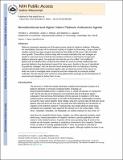Monofunctional and Higher-Valent Platinum Anticancer Agents
Author(s)
Wilson, Justin J.; Lippard, Stephen J.; Johnstone, Timothy
DownloadLippard_Monofunctional.pdf (3.163Mb)
PUBLISHER_POLICY
Publisher Policy
Article is made available in accordance with the publisher's policy and may be subject to US copyright law. Please refer to the publisher's site for terms of use.
Terms of use
Metadata
Show full item recordAbstract
Platinum compounds represent one of the great success stories of metals in medicine. Following the serendipitous discovery of the anticancer activity of cisplatin by Rosenberg, a large number of cisplatin variants have been prepared and tested for their ability to kill cancer cells and inhibit tumor growth. These efforts continue today with increased realization that new strategies are needed to overcome issues of toxicity and resistance inherent to treatment by the approved platinum anticancer agents. One approach has been the use of so-called “non-traditional” platinum(II) and platinum(IV) compounds that violate the structure–activity relationships that governed platinum drug-development research for many years. Another is the use of specialized drug-delivery strategies. Here we describe recent developments from our laboratory involving monofunctional platinum(II) complexes together with a historical account of the manner by which we came to investigate these compounds and their relationship to previously studied molecules. We also discuss work carried out using platinum(IV) prodrugs and the development of nanoconstructs designed to deliver them in vivo.
Date issued
2013-06Department
Massachusetts Institute of Technology. Department of ChemistryJournal
Inorganic Chemistry
Publisher
American Chemical Society (ACS)
Citation
Johnstone, Timothy C., Justin J. Wilson, and Stephen J. Lippard. “Monofunctional and Higher-Valent Platinum Anticancer Agents.” Inorg. Chem. 52, no. 21 (November 4, 2013): 12234–12249.
Version: Author's final manuscript
ISSN
0020-1669
1520-510X